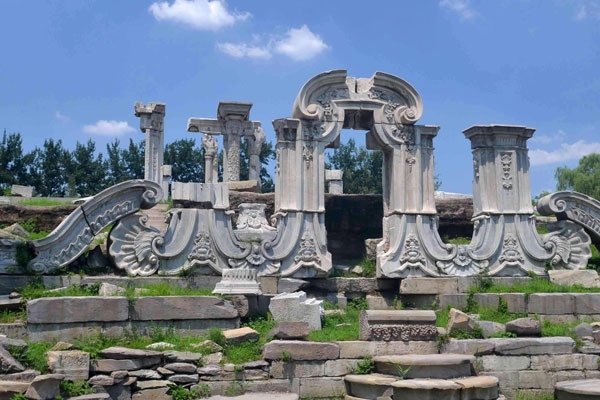


Dashuifa site in Yuanmingyuan [Photo/CGTN]
Beijing’s Old Summer Palace is marking the 157th anniversary of a massive sack during the Second Opium War, when thousands of Chinese cultural relics were either ruined or removed.
Located in the northwestern part of China’s capital city, the exquisite palace, known in Chinese as Yuanmingyuan, was extolled as the "Garden of Gardens" and the "Versailles of the East" during its heyday. It is renowned throughout the world for its grand and elegant landscape, with outstanding construction skills and extensive collection of gardens, architecture, art and historical treasures.
With a floor area of 350 hectares and building area of almost 200,000 square meters, Yuanmingyuan is composed of three gardens: Yuanmingyuan, Changchunyuan and Qichunyuan. In January 1988, it was named as a key national cultural relic protection site. And in the same year, the palace was officially opened to the public, who were able to visit free on Wednesday to mark the anniversary.
They had the opportunity to watch on-site excavation work conducted by professional archaeologists as well as attend experts' and scholars’ lectures on the park's history and cultural relics – all for free.
The initial construction of the palace began in 1707 during reign of Emperor Kangxi, and the expansion continued for next 150 years in the Qing Dynasty (1636-1912 AD). It was used to serve emperors as an imperial garden to take a rest or handle state affairs during the hot summer months.
However, Anglo-French forces sacked and looted Yuanmingyuan and burned it to the ground on October 18, 1860 during the Second Opium War. The garden subsequently suffered continual damage at the hands of warlords, bandits, and the Eight-Power Allied Forces.
Since 1996, a total of three excavations have been conducted in the palace resulting in the discovery of more than 50,000 pieces of relics so far. The most recent excavation began in 2013 and will last until 2020, making it the largest excavation project in Yuanmingyuan.
But numerous relics remain overseas. UNESCO estimated in 2006 that about 1.6 million Chinese relics were in the possession of 47 museums worldwide, including one million from the Old Summer Palace alone.

The reinforced historical site at the Old Summer Palace, also known as Yuanmingyuan, Beijing, capital of China. [Photo/CGTN]
Chinese government and civic individuals have been working hard to bring the pieces back home during the past years through purchasing, donations, auctions and other means. In 2006, a new strategy was put into action to collect and request their return. Despite the park’s hard work, fewer than 100, mainly stone sculptures, have been repatriated so far.
In late October, Yuanmingyuan will jointly hold the first-ever movie season with the Beijing Film Academy, including a series of interactive film-watching sessions.
The film season is expected to last a week, showcasing various classic and patriotic films to citizens for free – in an effort to remind Chinese people of the unfortunate past while looking to a bright future at the same time.
 Fire brigade in Shanghai holds group wedding
Fire brigade in Shanghai holds group wedding Tourists enjoy ice sculptures in Datan Town, north China
Tourists enjoy ice sculptures in Datan Town, north China Sunset scenery of Dayan Pagoda in Xi'an
Sunset scenery of Dayan Pagoda in Xi'an Tourists have fun at scenic spot in Nanlong Town, NW China
Tourists have fun at scenic spot in Nanlong Town, NW China Harbin attracts tourists by making best use of ice in winter
Harbin attracts tourists by making best use of ice in winter In pics: FIS Alpine Ski Women's World Cup Slalom
In pics: FIS Alpine Ski Women's World Cup Slalom Black-necked cranes rest at reservoir in Lhunzhub County, Lhasa
Black-necked cranes rest at reservoir in Lhunzhub County, Lhasa China's FAST telescope will be available to foreign scientists in April
China's FAST telescope will be available to foreign scientists in April "She power" plays indispensable role in poverty alleviation
"She power" plays indispensable role in poverty alleviation Top 10 world news events of People's Daily in 2020
Top 10 world news events of People's Daily in 2020 Top 10 China news events of People's Daily in 2020
Top 10 China news events of People's Daily in 2020 Top 10 media buzzwords of 2020
Top 10 media buzzwords of 2020 Year-ender:10 major tourism stories of 2020
Year-ender:10 major tourism stories of 2020 No interference in Venezuelan issues
No interference in Venezuelan issues
 Biz prepares for trade spat
Biz prepares for trade spat
 Broadcasting Continent
Broadcasting Continent Australia wins Chinese CEOs as US loses
Australia wins Chinese CEOs as US loses